Jan Jasicki

The "Save the Memory" project is a series of video interviews with witnesses of history from 1939- 1956. It was created to preserve the memories and experiences of the heroes and heroines from this period.
At the beginning of the film. the logos of the Polish History Museum are illustrated, featuring a yellow crown, gray wings, and the letter "P" in red with the Polish flag in the center. Also detailed is the phrase ”Patriotism of Tomorrow” with the letter "P" in black. Underneath these icons, there is a white inscription "Project co-financed by the Museum of Polish History in Warsaw as part of the Patriotism of Tomorrow program."
Then there is information about the protagonist - Jan Jasicki, a student of the
clandestine classes, an employee of the Bata company. He is the son of Janina Jasicka, alias "Stara" -
a Home Army nurse. After the war, he became an employee of the Bureau of Mining Projects.
Former Sailor, skier, photographer, social activist, and journalist.
The man is older, with short, gray hair and light eyes. A portrait from the chest up. He is dressed in a
white shirt and black pin-striped suit with a brooch pinned on it. He is sitting on a white chair in a
dark room against a maroon curtain.
Throughout the film, she shows footage from her private archive, family photos and documents. At
the end of the film appears a blackboard with the blue logo of the Historical Museum of the City of
Krakow and the white logo of Oskar Schindler's Emalia Factory Lipowa 4. At the bottom is the website
address: www.ocalicpamiec.mhk.pl and the year of production - 2013.
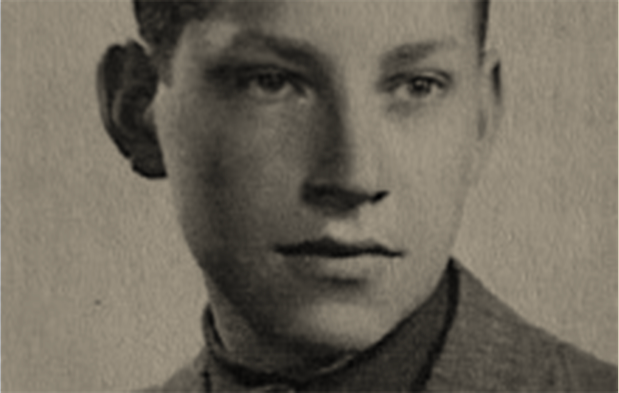
Jan Jasicki
1929 – 2024

Black and white portrait photo of teenage Jan. He has strongly outlined lips. He is dressed in a dark collar shirt and jacket. He is facing his left semi-profile, not looking straight into the lens.
Jan Jasicki (21 VI 1929, Bydgoszcz – 28 XII 2024, Kraków) Uczeń tajnych kompletów, pracownik Bata Schuh- und Leder Werke w Radomiu, po wojnie pracownik Biura Projektów Górniczych, żeglarz, narciarz, fotografik, społecznik, dziennikarz.
Son of Józef, a graduate of the Jagiellonian University, employee of the Tobacco Monopoly, and Janina (née Piątek), teacher, AK nurse pseudonym Stara, social activist.
The Jasickis came from Krakow, but before Jan was born his father Józef Jasicki got a job at the State Cigar Factory in Bydgoszcz. There Jan spent the first years of his life. After a one-year break, when he and his mother settled in Koscielisko in the house of Karpiel Bulka. Here he attended school and learned to ski, which became one of his lifelong passions.
In May 1939. The Jasickis, along with the evacuated Cigar Factory, moved to Lodz. There they were found by the outbreak of war. Initially, Lodz was incorporated into the General Government, but as a result of efforts made by the German minority, on November 9 it was announced that the city had been incorporated into the Third Reich as part of the so-called Wartheland.
The Jasickis' three-room apartment, located near the Łódź Kaliska train station, became a shelter for victims of German attacks on passenger trains. Jan watched his mother as she helped the refugees and shared food with them. In case of displacement, at his mother's insistence, he prepared a pack for himself with the most necessary things.
In early 1940, Jan's father lost his job. The Germans threw the family out of the apartment. On May 12, 1940, after receiving permission, they left for Kraków. They settled in a house belonging to Piotr and Józefa Jasicki, Jan's grandparents. They occupied a small room in the attic. Already living at 28 Zarzecze Street were: two sisters of Jan's mother, including one with her husband and son. Jan's mother Janina knew German and had obtained a fake work card from Landwirtschaftcentral Stelle in Krakow, a company that purchased herbs. She was able to move more freely around the city and travel outside Krakow. Jan helped his mother sew the derby bags she traded in. By the end of 1940, Jan's father was employed as a croupier at a casino in Warsaw.
Jan attended a Polish public elementary school on Kazimierza Wielkiego Street, then on Mazowiecka Street. He also learned to play the piano in private lessons. In 1942, he began attending clandestine classes, where he completed the first grade of junior high school. He witnessed the arrest of his father. Jan was worried about him and his mother, who traveled to the prison in Warsaw (in Mokotow) with bribes so that Jozef would not be sent to a camp. In early 1943, Jozef Jasicki was released from prison. In March 1943, fearing deportation to labor in the Third Reich, Jan and his father left for Radom from work at Bata Schuh- und Leder Werke. The work for 14-year-old Jan was hard, initially working on the production line, then in shipping.
Janina Jasicka, after the departure of her son and husband, was employed as a nurse for Doctor Józefa Sojka at the Social Security Office. This type of work was a good camouflage for underground activity. Janina became a nurse a.k.a. Stara in the "Zelbet "AK grouping. She also cooperated with the partisan unit "Harnaś", including during the action of carrying weapons to Mikołajska Street for the unit. In July 1944 Jan and her father returned to Kraków and happily lived to see the end of the war. – BŁ
Jan Jasicki recalls: "The war ended, I started my education at Sobieski Gymnasium, then at the High School of the Fr. Piarists. Immediately after the war, in 1946, being in the Sailing Scout Troop, we canoed down the Vistula to Gdansk in three canoes. In the following years, I sailed with my friends on Lake Rożnowskie in a jointly-made sailboat. This was the fulfillment of my dreams from the time of the occupation. After passing my high school diploma, I began my studies at the AGH University of Science and Technology, which I completed in 1955 with a degree of M.Sc. in mechanization of mining and metallurgy. From 1946 we lived in a cigarette factory at 10 Dolnych Młynów Street until my mother got an apartment at Rydla Street in 1955. In the same year, I got married civilly to Irena (née Niewinska) and started working at the Bureau of Mining Projects at 25 Lubicz Street, and my wife at the Bureau of Railway Projects. After my church wedding in February 1956, I moved into my in-laws' apartment at 14/4 Warszawska Street on the first floor. While still a bachelor, I spent my vacations in the winter in Zakopane skiing, I was a ski instructor, and in the summer I sailed on Lake Rożnowskie, on a new sailboat made by me and my friends. Since 1957, we sailed on the Masurian lakes on Tourists made by us in a friend's garden (4 pieces). I worked in the office for 35 years and retired at the age of 60. I enjoyed designing, had good contacts in the mines, and enjoyed coming to work. For my work, I received the Silver and Gold Cross of Merit and the rank of mining director of the first degree. In 1960, a son Marek was born. In 1980 I bought a plot of land (12 acres) in Kryspinowo, where we spent our days off from work. The end of work coincided with the end of communist Poland and great economic changes. There was no longer a demand for huge design offices. Solidarity and regime changes enabled me to be socially active, a passion that I inherited from my mother [Jan]. Working in the Civic Committee of the City of Kraków, preparing for local elections and for the Sejm and Senate consumed all my free time, as did my wife. After the Kraków City Council passed the establishment of 18 auxiliary districts in Kraków, in the first elections to district councils in 1991 I was elected as a councilor of District I Stare Miasto and became deputy chairman of the Council. In the 2nd and 3rd terms, I continued to be active in the Council in this position. I was also involved in the local newspaper published by the District Council, for 5 years I was the editor, wrote articles, did interviews with interesting residents of Krakow, and took photos of local celebrations. At the same time, I was chairman of the Parish Council at St. Florian's Church and captured the life of the parish in photographs, which were used in numerous publications dedicated to St. Florian's Church. The year 1985 brought new changes. My son left for Berlin, my mother-in-law died, and the apartment was too big, so I exchanged it for a smaller one on the third floor. In 1995, grandchildren - two boys - were born in Berlin. From then until the death of my wife in 2006, we took care of them to the best of our ability. In 2015, I left my apartment on Warszawska Street and moved into the L.A. Helcl Nursing Home in Krakow. I try to continue to be useful to other people. I was the initiator of the Helcl Home Support Society, of which I was president. I am active in the Krakow Photographic Club and the Association of Polish Journalists. Recently I became an honorary member of the Railway Cultural Society. Did my life fall in interesting times? I think so. I went to a different school almost every year, not because of my studies and behavior, but because that's how fate made me, and the apartments I lived in for more than a year changed 12 times, and I survived World War II, then one can say yes."
Photos are from the collection of Jan Jasicki.
Gallery
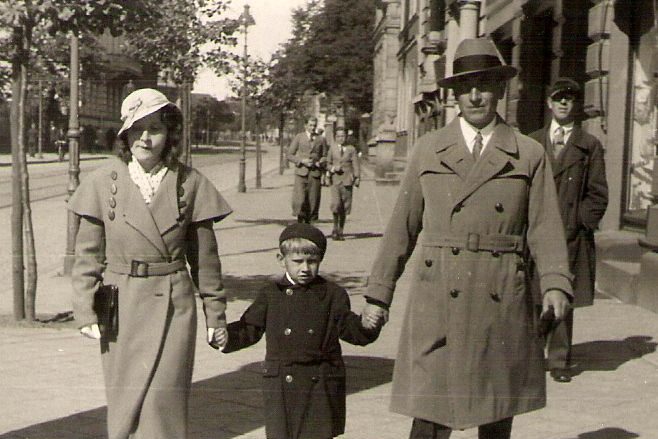
Jan Jasicki with his parents - Janina and Józef, Bydgoszcz, 1933

Black and white photo of a few-year-old Jan with his parents on a walk in the city. Behind them you can see passers-by and tenement houses. The boy has light-colored hair and a dark, crooked beret. He is wearing a long black coat and high black socks. To his right walks his mother Jan. The woman is middle-aged, with dark curls and a white hat. She is dressed in an elegant long coat. In one hand she holds a purse - a clutch bag, and with her other hand, she holds little Jan. Her husband, Józefa, is holding his son with his other hand. The man is about forty years old and is wearing a dark hat. He is dressed in a white shirt and tie, black pants and a long, button-down trenchcoat.
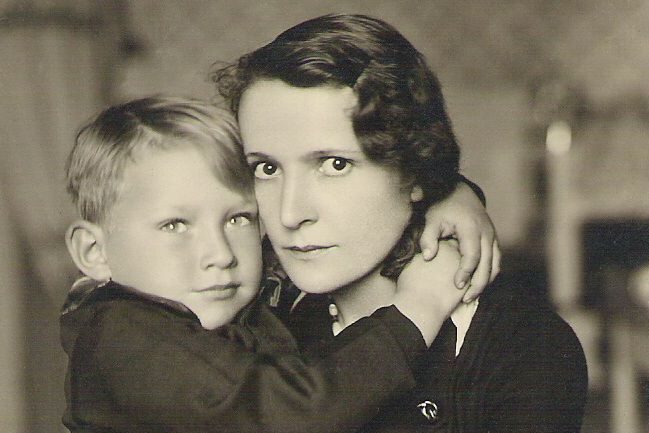
Jan Jasicki with his mother Janina, Bydgoszcz, 1933

Black and white photo of four-year-old Jan with his mother Janina. They pose hugging each other in the background of the room, shot from the waist up. The boy sits on the woman's lap and embraces her neck with his hands. Jan has blond hair, combed to the side. He is dressed in a black shirt and shorts. The woman has curly hair, pinned up with a bobby pin. She has a distinctive straight nose and narrow lips.
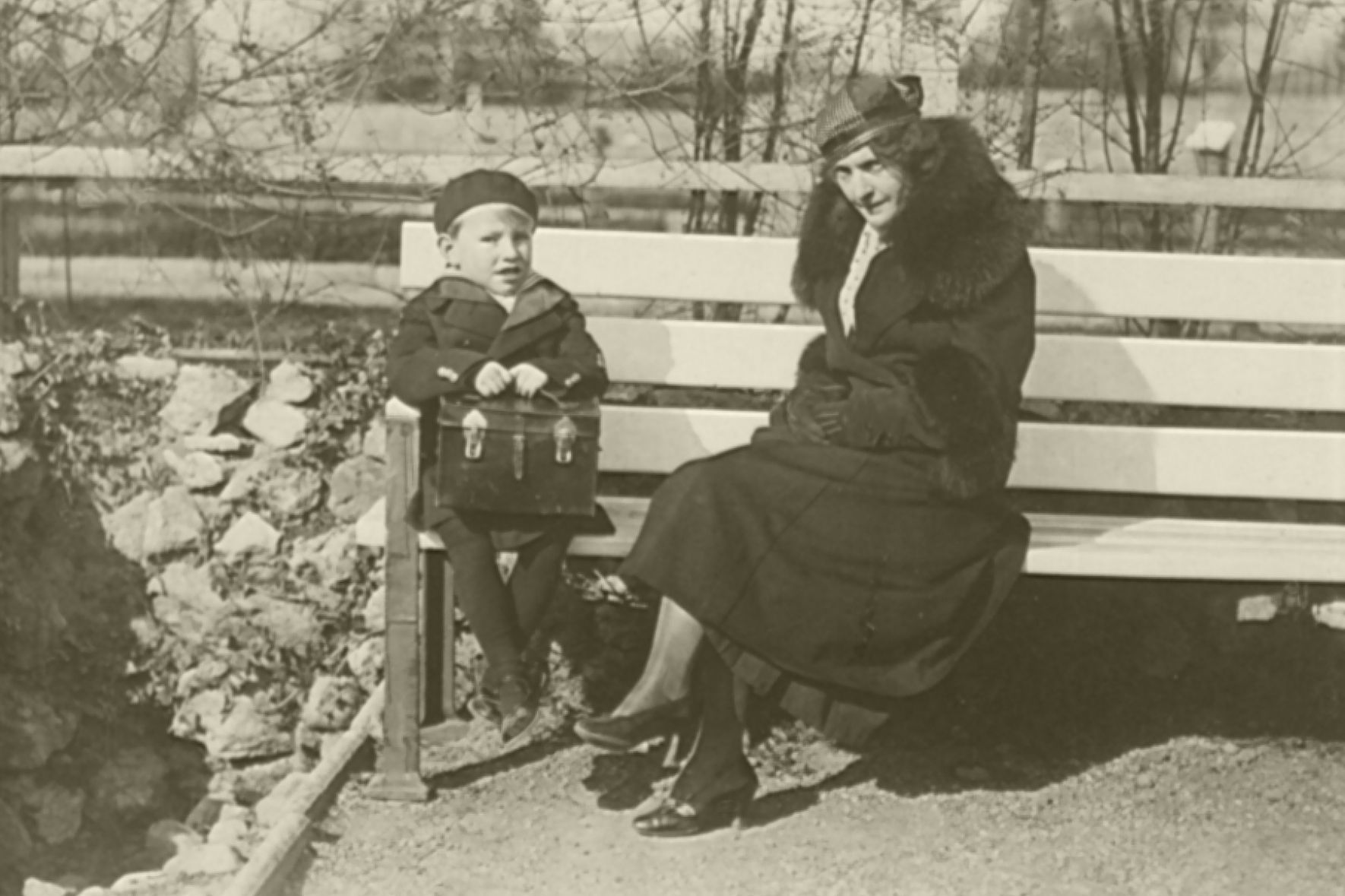
Jan Jasicki with his mother Janina in the botanical garden, Bydgoszcz, ca. 1934

Black and white photo of five-year-old Jan with his mother in the botanical garden. Behind them are visible trees without leaves and grass covered with a thin layer of snow. Both are dressed warmly, wearing long coats and berets. They are sitting on a white bench, and the boy is holding a black trunk on his lap.
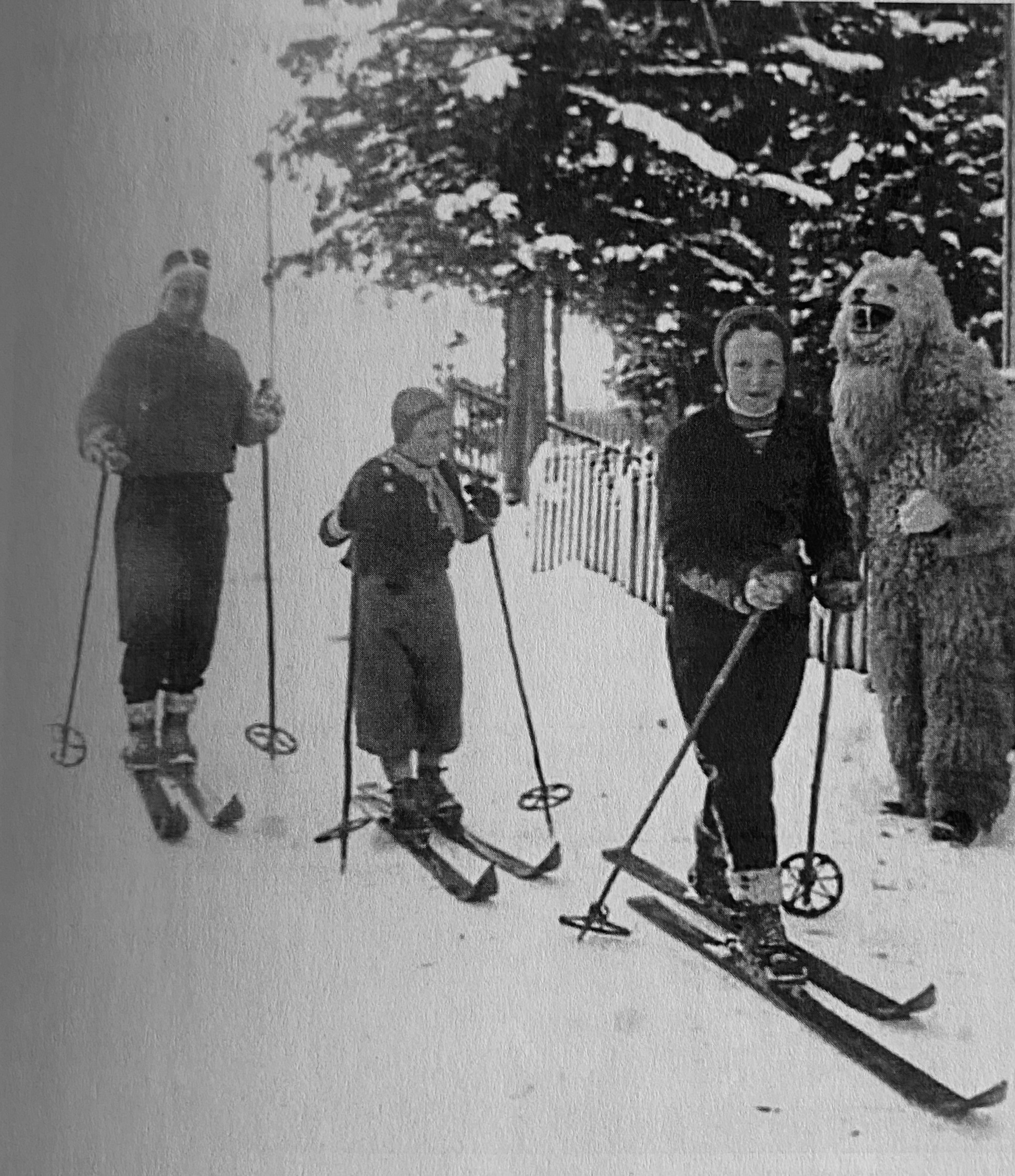
Jan Jasicki with his parents Janina and Józef on skis, Kościelisko, 1935/36.

Black and whitephoto of a few-year-old Jan with his parents on skis in Koscielisko. They are standing in the snow, with a low snow-covered fence and coniferous trees visible in the background. The family is dressed in ski outfits and hats, with ski poles in their hands and skis on their feet with a sharply raised front. They are standing on the snow. Next to them, in front of the fence stands a person dressed as a bear.
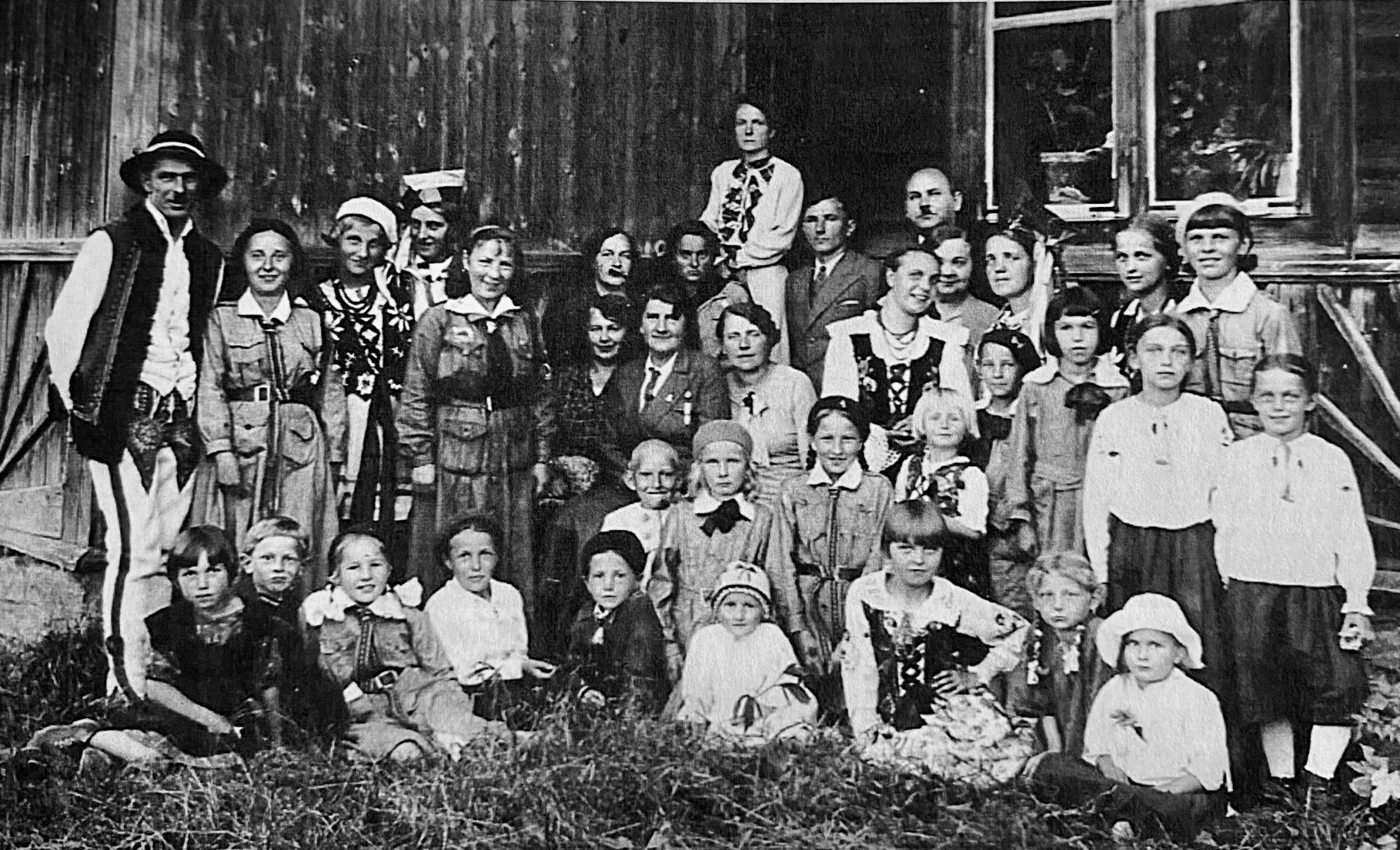
Jan Jasicki with his classmates, Kościelisko, 1935/36

Jan's black and white class photo in Koscielisko. The photo was taken against the backdrop of a wooden hut. The group consists of a dozen children and their chaperones. Behind them are men and women in highland costumes.
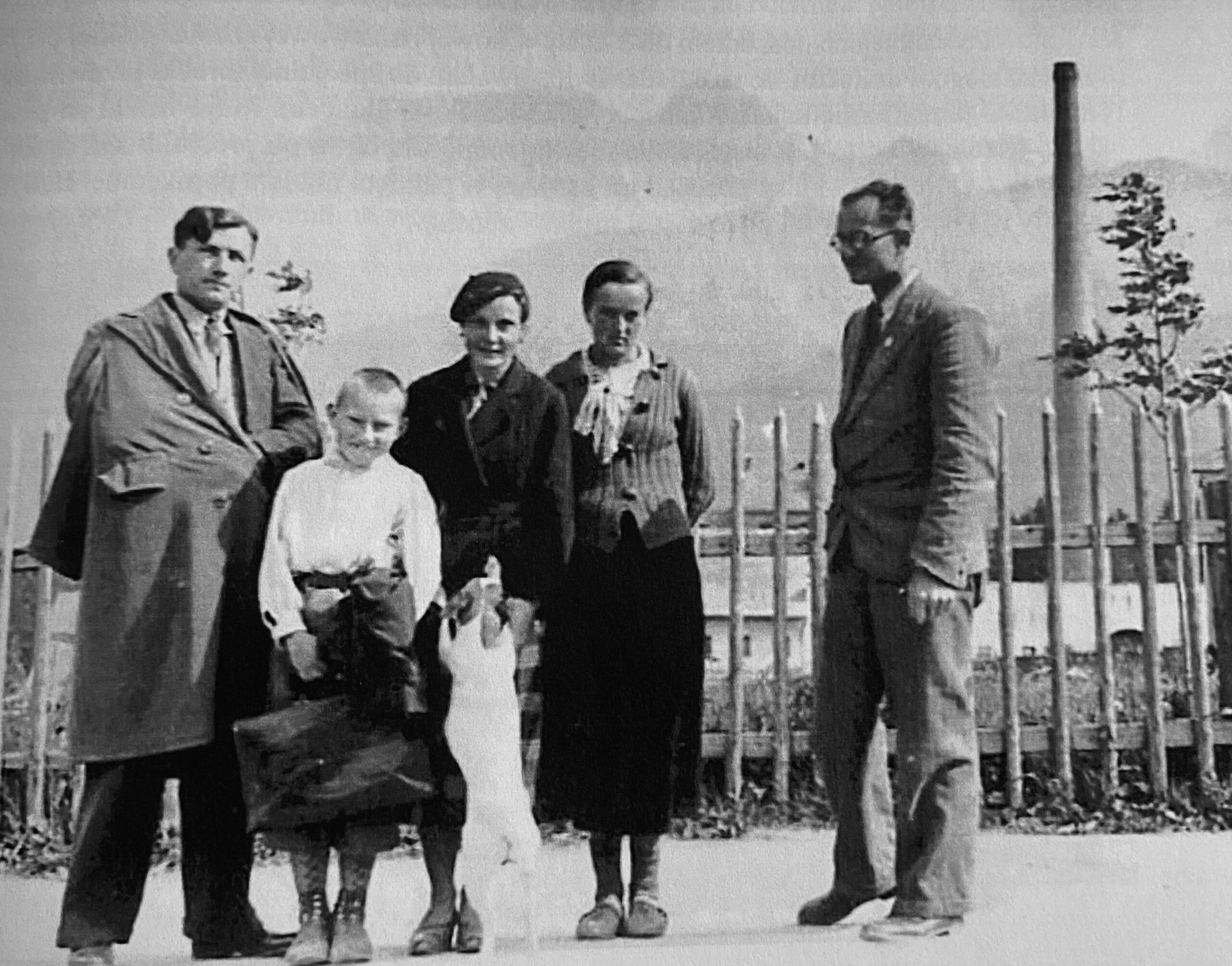
Jan Jasicki with his mother Janina and school teachers, Kościelisko, 1935/36

Black and white photo of Jan with his mother and teachers. A group of five people are standing in front of a low picket fence. The men are dressed in suits and the women in blouses and long skirts. The boy has his hair cut short and a white shirt, and in his hands he holds a jacket and a bag. Next to him stands his mother, who is playing with a small white dog, standing on its hind legs.
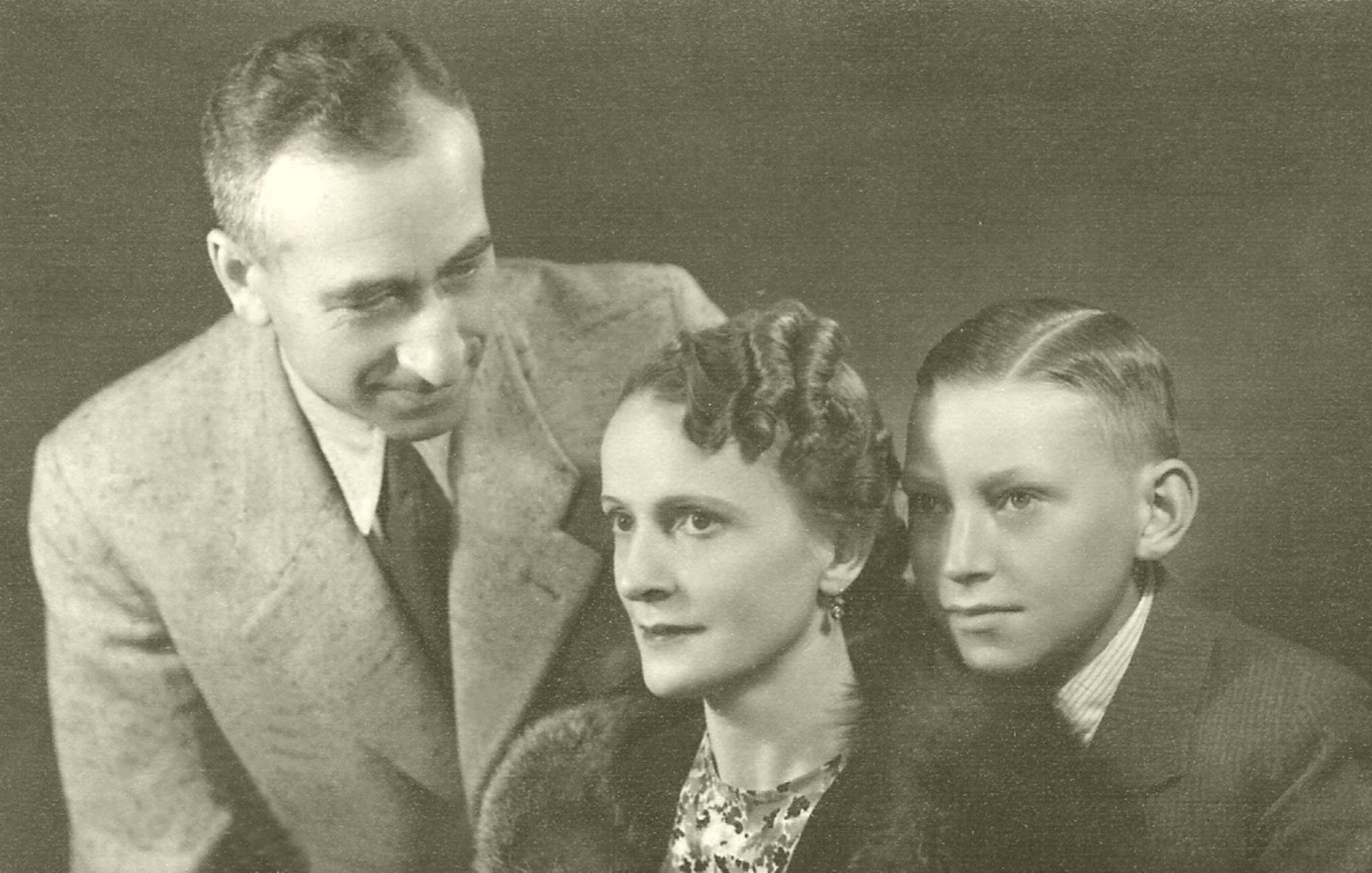
Jan Jasicki with his parents Janina and Józef, Kraków, 1940-1945

Black and white portrait photo of teenage Jan with his parents. On the left is his father Józef, who is leaning towards his wife. The father is dressed in a white shirt, tie and light-colored jacket. In the centre is the mother – she has wavy and side-parted hair, arched eyebrows and a slight smile. She is dressed in a fur coat and a floral blouse. Jan rests his chin on her shoulder. He has his hair combed in brylcreem, and is dressed in a white shirt and thin-striped jacket.
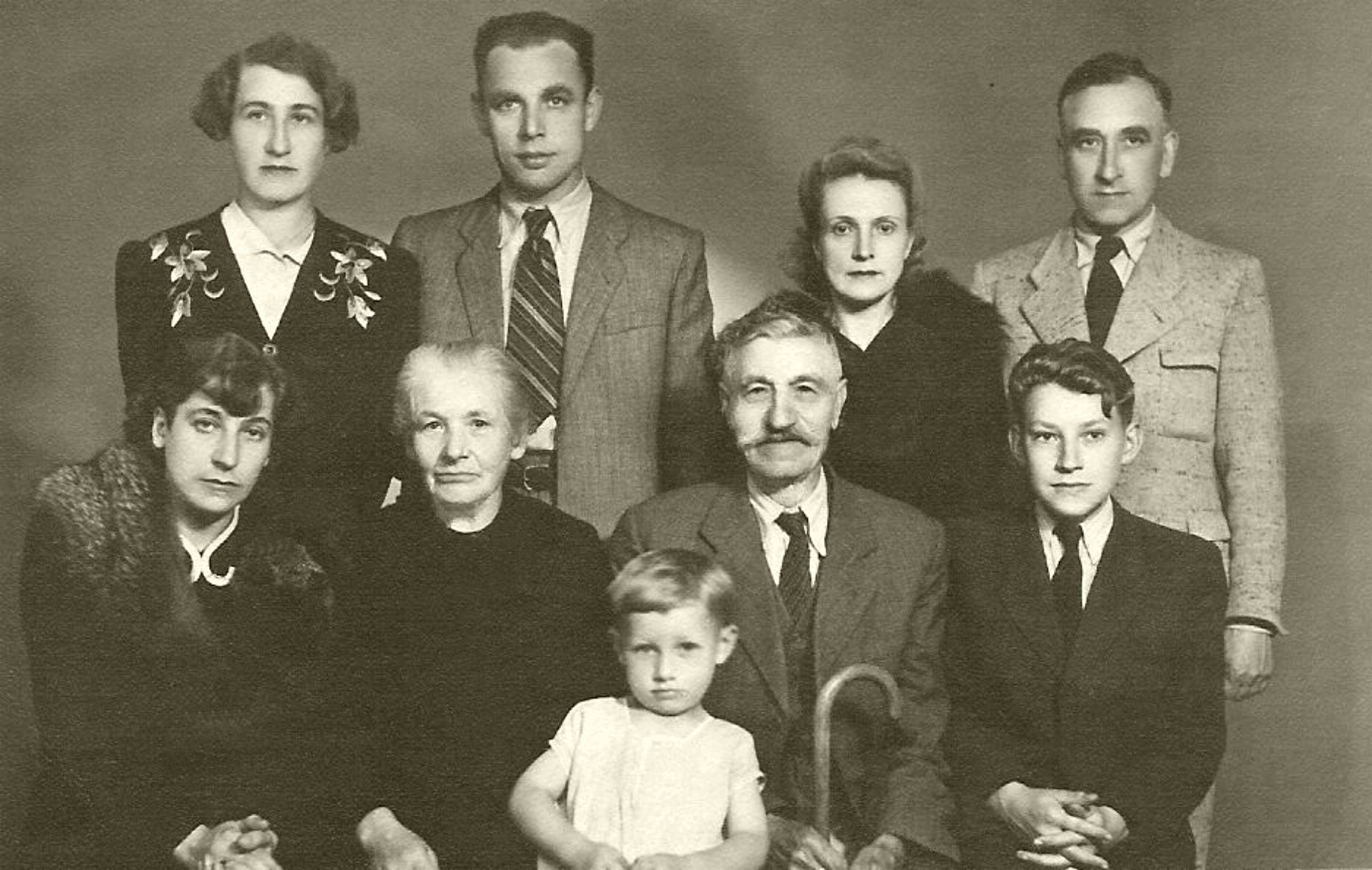
Jan Jasicki with his whole family that lived at 28 Zarzecze Street, Kraków, 1940-1945

Black and white photo of Jan with his family. They lived at 28 Zarzecze Street in Kraków. Two women and two men stand in a row against a dark background. In front of them posing seated from the left are two women, an olderman and a teenage Jan. In the foreground stands a very young boy. The family is multi-generational, elegantly dressed - the women in dresses and the men in suits and ties.
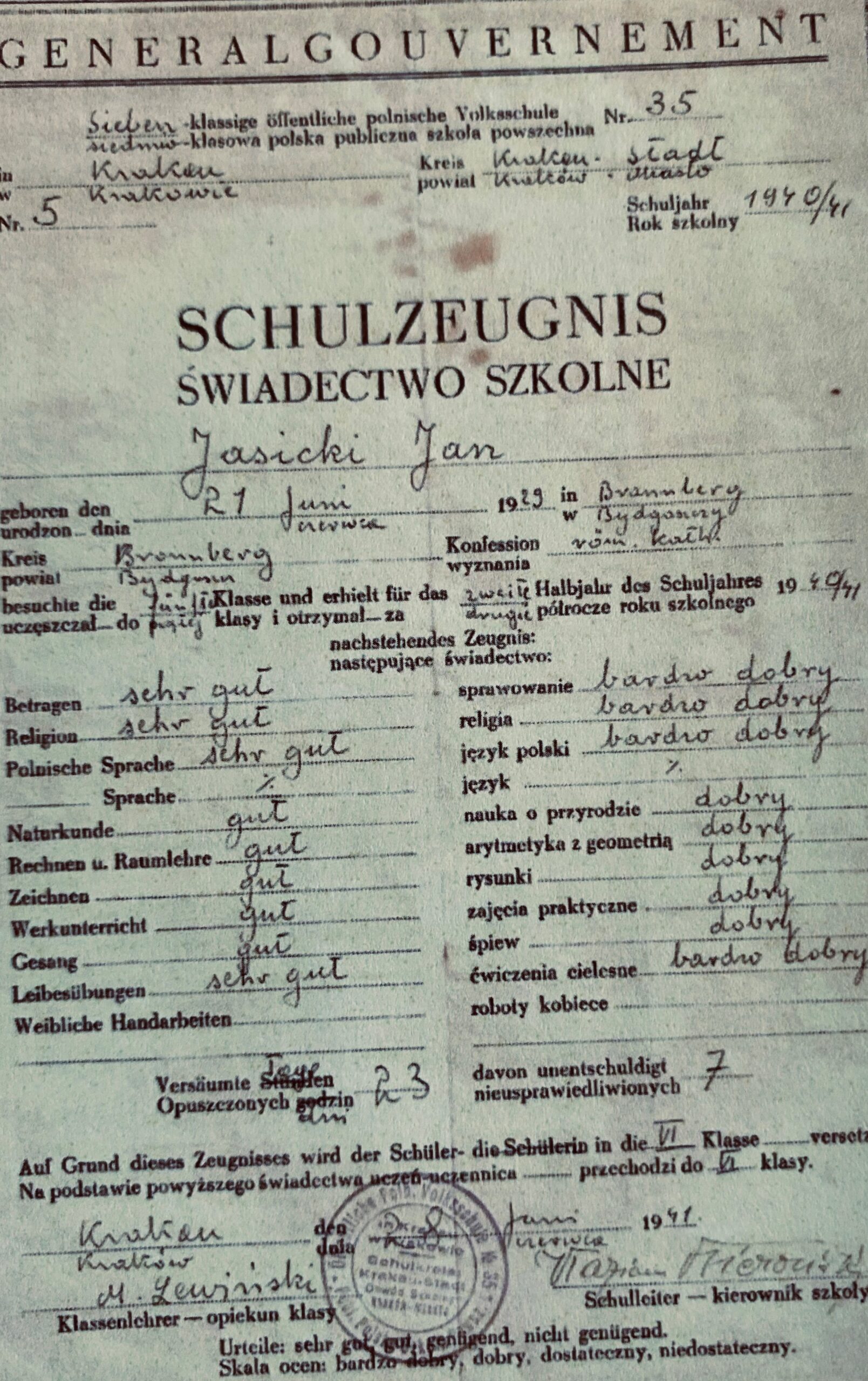
School certificate from the Polish Public Common School from the school year 1940/41, Kraków

Jan's school certificate from the Polish Public Common School from the 1940/1941 schoolyear. The document is written in two languages. At the top is the inscription "School Certificate" in German, and underneath in Polish. Below that, you can read the grades in German on the left and in Polish on the right. In the lower part of the document are the signatures of the class supervisor and the head of the school, as well as the stamp of the institution.
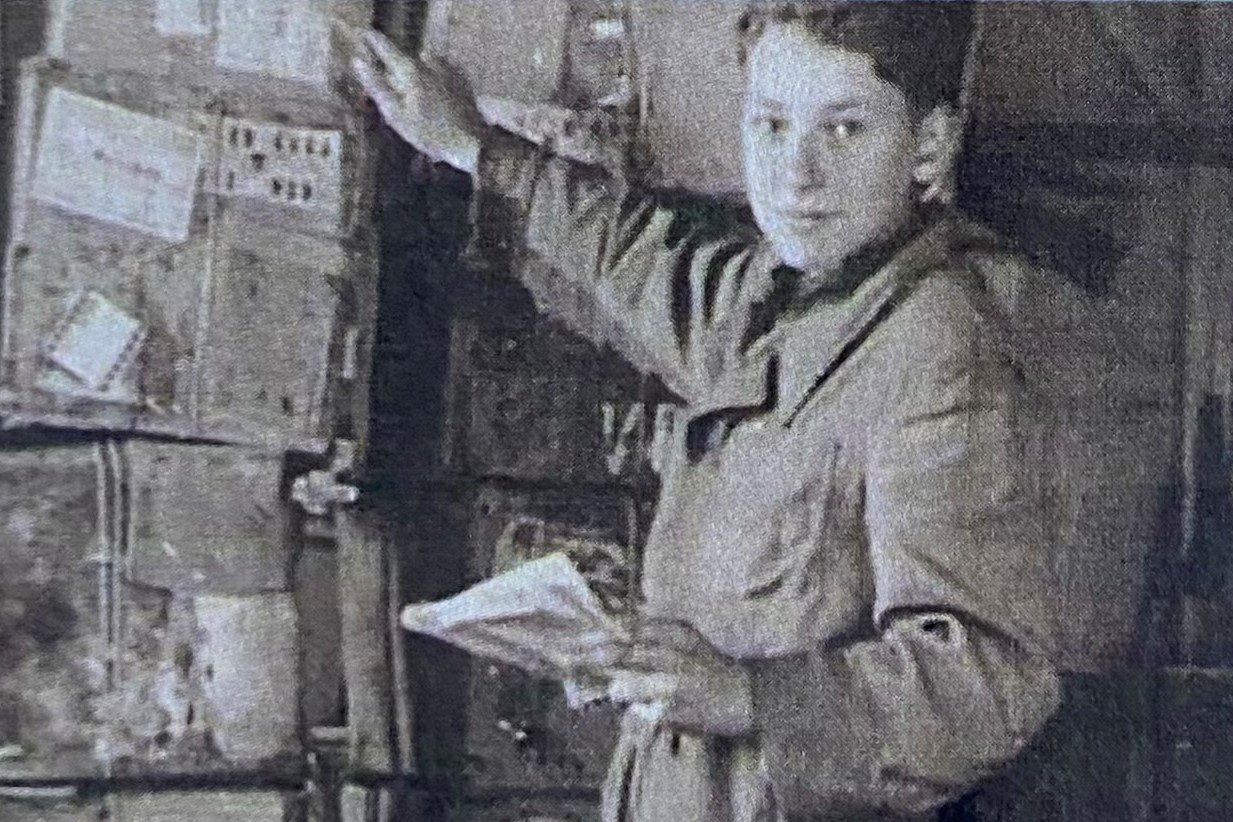
Jan Jasicki at Bata Factory, Radom, 1943/44

A black and white photo of a teenage Jan. The boy poses sideways, facing the lens, smiling. He has short, curly hair, and is dressed in overalls. He is standing by a stack of cargo trunks, with his hand on one of them and holding a notebook in the other.

Jan Jasicki at Bata Factory, Radom, 1943/44

Black and white photo of eight men, including Jan. The photo was taken at the Bata factory in Radom. Behind them are machines and a rack with a coat and hat hanging from it. Sitting at a wooden table lined with documents are four men, all in their mid-twenties. Fifteen-year-old Jan sits among them. Above the group stands two men in their mid-thirties. All are dressed in jackets or working clothes.
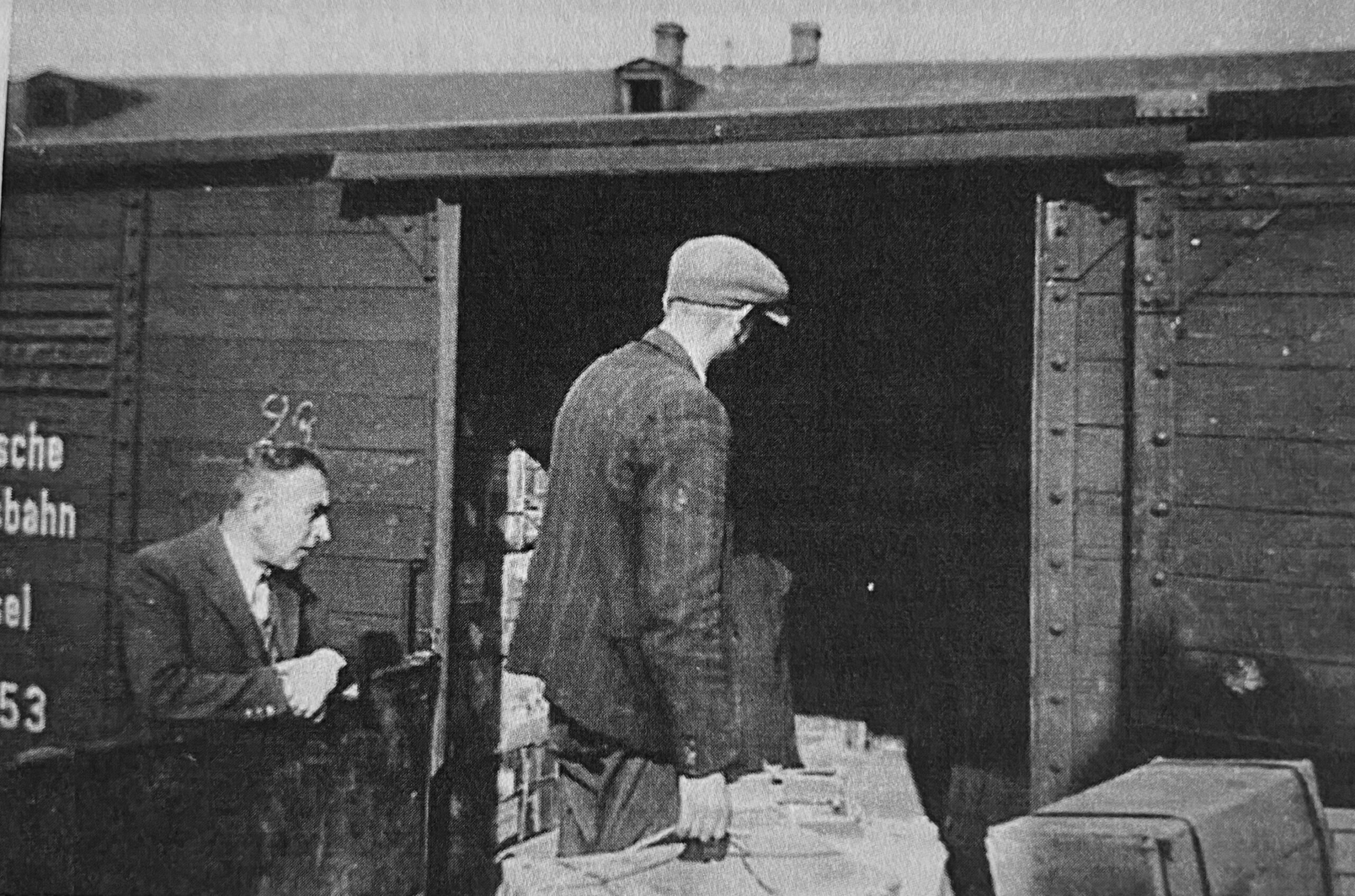
Jan Jasicki with escorts at Bata Factory, Radom, 1943/44

Czarno-białe zdjęcie Jana wraz z konwojentami w fabryce Bata w Radomiu. Mężczyzna jest zwrócony plecami do obiektywu, wchodzi wagonu pociągu, niosąc w rękach niezłożone, kartonowe pudełka. Ubrany jest w kaszkiet i marynarkę w paski. Po jego lewej stronie stoi mężczyzna w średnim wieku, w garniturze.
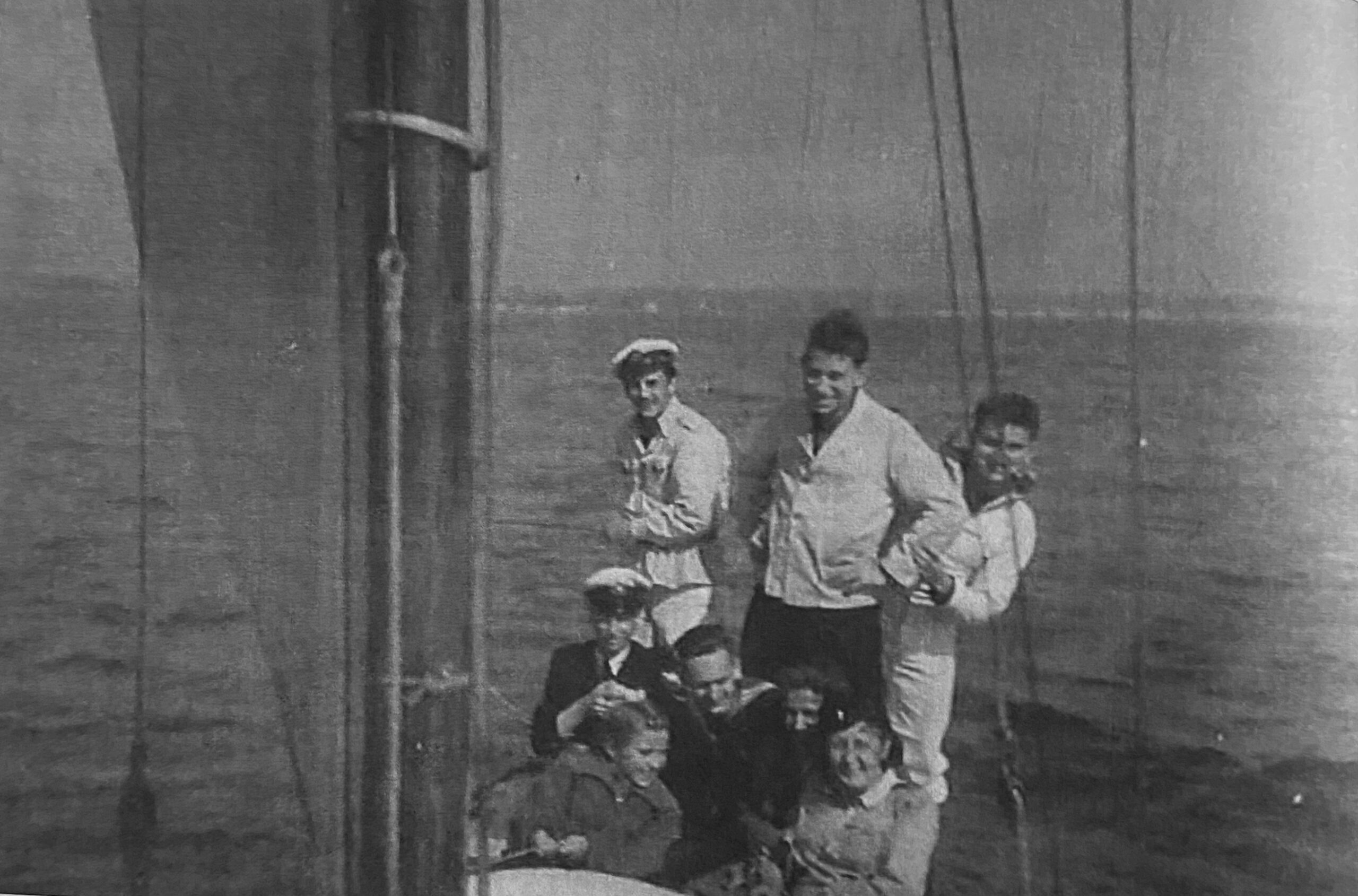
Jan Jasicki on the yacht Wyga during the opening of the sailing season, Gdynia, 1947

Black and white photo of Jan Jasicki on the yacht "Wyga" during the opening of the sailing season in Gdynia. The boy is standing on the stern accompanied by seven people, including the yacht's captain and a young girl holding the mainsail halyard.
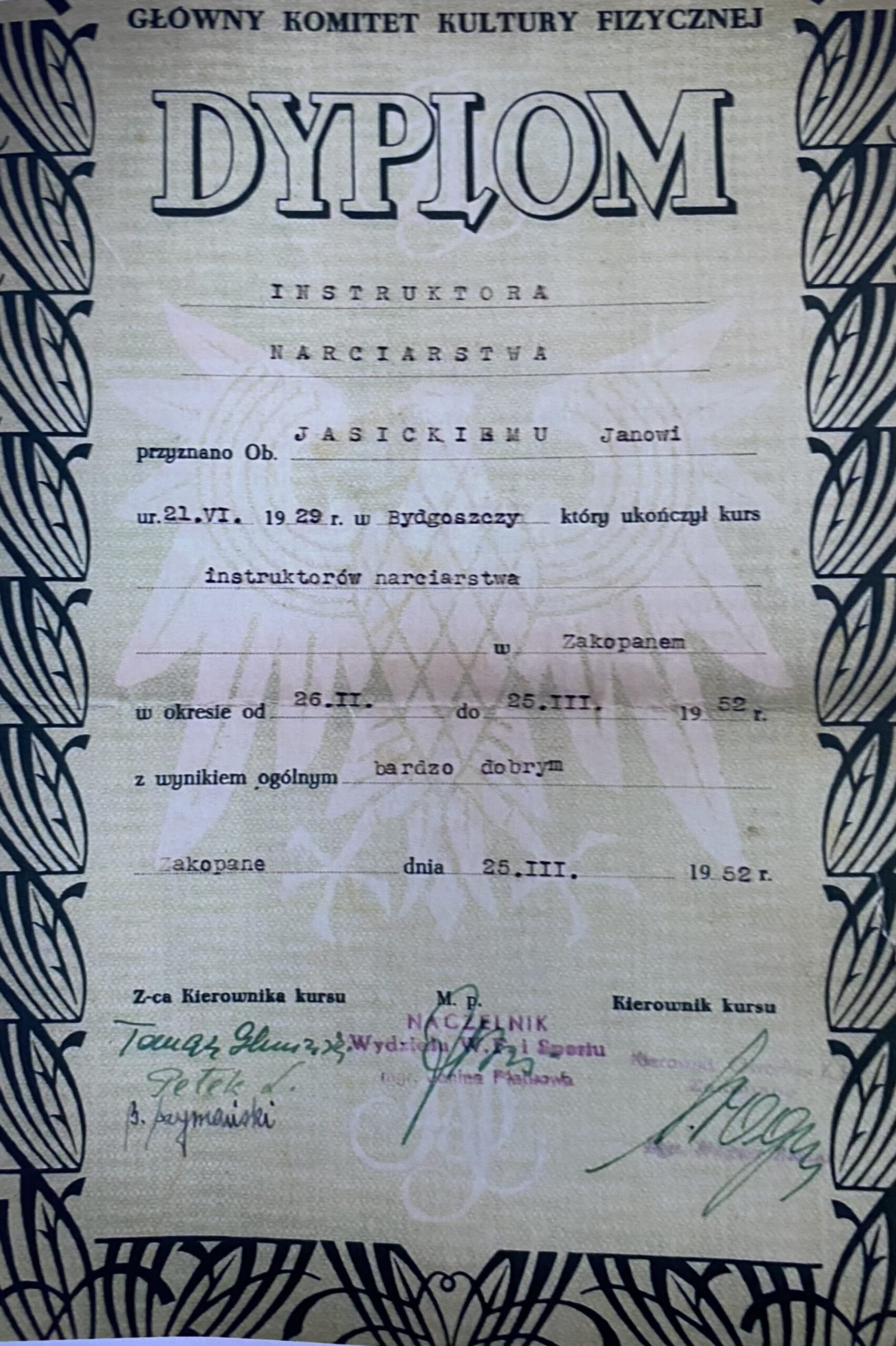
Jan Jasicki's ski instructor diploma, Zakopane, 1952

Diploma of ski instructor for Jan Jasicki. The course was completed with a very good result; It was issued in Zakopane in 1952.
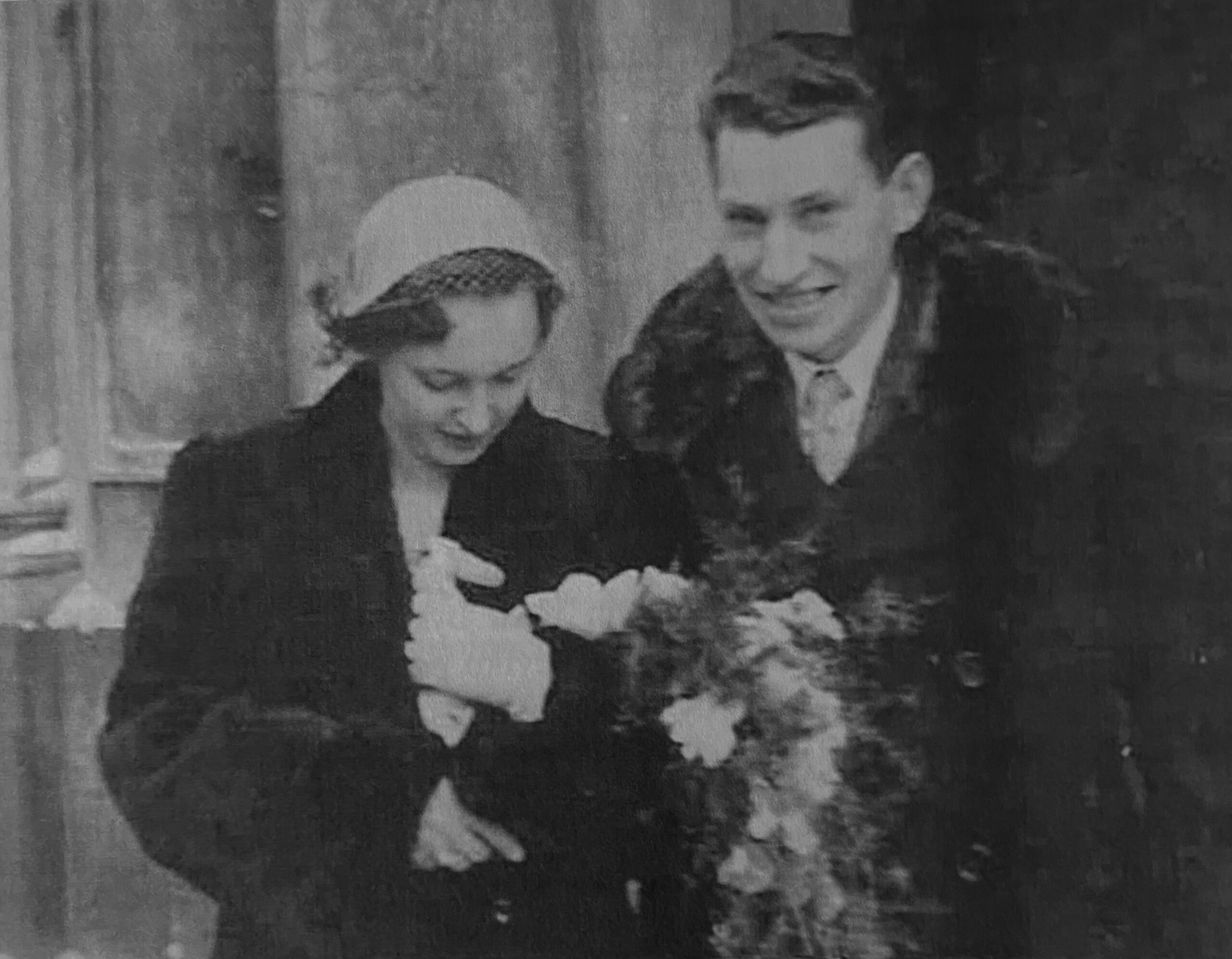
Jan Jasicki with his wife Irena née Niewinska, Kraków, 1956

Czarno-białe zdjęcie Jana z żoną – Ireną, z domu Niewińską. Para wychodzi z drewnianego budynku. Są elegancko ubrani i uśmiechnięci. Irena idzie tuż przy mężu, ma na sobie białe nakrycie głowy, a w rękach trzyma długi bukiet białych kwiatów, na które spogląda. Mężczyzna patrzy w stronę obiektywu, uśmiecha się. Ubrany jest w futro, pod którym ma koszulę i krawat.
